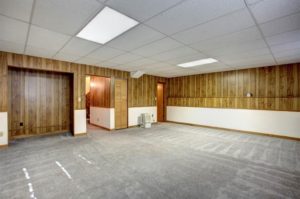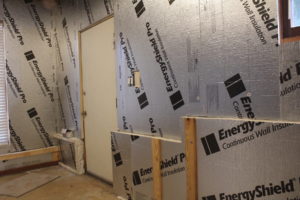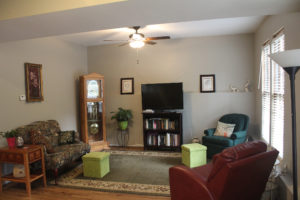Project Challenge

In the fall of 2018, homeowners Jon and Rachel decided to move Jon’s mother into their home in Marietta, GA after her husband passed away. With the move-in date set, the couple had only a few months to prepare a new basement suite for her arrival. While the basement had been remodeled 20 years prior, it needed modern updates before Jon’s mom could comfortably live in the space.
It was evident the entire basement level lacked proper insulation, as the temperature could not be well controlled. The basement also had a strong, musty odor due to condensation issues. Before Jon and Rachel could tackle the complete mother-in-law suite remodel, including a new floor plan and well-equipped kitchenette, they needed to improve the basement’s foundational elements to create a comfortable living environment.
Jon and Rachel decided that a dedicated HVAC unit had to be installed in order to improve heating and cooling. The couple discussed that while a new HVAC unit was necessary, without adequate insulation, it’d be tough to heat and cool the basement effectively. They also knew that the space needed a vast improvement in moisture control to remove its musty odor.
Approach

To provide a relaxing and healthy living space while keeping heating and cooling costs low, Jon and Rachel required a highly energy efficient insulation solution. The couple found that ideal solution in EnergyShield® continuous wall insulation from Atlas Roofing Corporation.
With a demonstrated track record of improving long-term energy efficiencies, moisture management capabilities, and superior fire performance, EnergyShield is a high-performance wall insulation trusted by the pros in commercial buildings across the country. EnergyShield is NFPA 286 compliant, meaning it can be left exposed on the interior of the building without it needing to be covered with a code-approved thermal barrier such as ½ gypsum. Because of its affordability and easy installation, EnergyShield offers a great option for homeowners and residential construction projects as well. The product provides a high R-value of 6.5 per inch, which makes EnergyShield more than suitable to use in order to meet the 2018 IECC (International Energy Conservation Code) requirements. For climate zone 3 wood framed walls, the 2018 IECC requires either R 20 in the cavity or R 13 in the cavity and R 5 continuous insulation. By adding the R 5 continuous insulation outbound, you are reducing the thermal bridging. EnergyShield also features durable foil-facers with water resistive barrier attributes. These features can assist in mitigating mold, which would address Jon and Rachel’s strong basement smell.
While making their decision, the couple also valued EnergyShield’s GREENGUARD Gold certification. GREENGUARD Gold testing requires that building products designed for indoor spaces meet some of the world’s most rigorous limits for chemical and particle emissions, including emissions of VOCs, into their environments. Recognized and referenced by over 400 codes, this certification provides designers, architects and contractors an easy way to identify premium products that aid in the creation of healthier indoor environments and release fewer pollutants that can contribute to health issues, including asthma and other respiratory issues. The GREENGUARD Gold certification is designed to determine if a product is suitable for an environment where people, particularly children and sensitive adults, spend extended periods of time- such as in a home. By choosing a GREENGUARD Gold certified product, Jon and Rachel ensured that Jon’s mother would live in a safer, greener indoor environment and their home would feature more sustainable building products.
In new homes, continuous insulation is traditionally installed outbound of studs and sheathing. Yet in remodeling projects, continuous insulation may be installed inbound of the studs. Because Jon and Rachel were remodeling an older home, and because their basement walls were situated below grade rather than above ground, they decided to install the wall insulation inbound of the studs. Although doing so sacrificed a few inches of floorspace, it ultimately created a much healthier and more energy efficient living environment because the sheets of insulation are tightly placed end-to-end, eliminating the possibility of thermal bridging.
Impact

With the EnergyShield insulation fully installed and the mother-in-law suite completed, a happy new family member moved in. Jon, Rachel and Jon’s mother-in-law all agree the basement is now the most comfortable space in the house. Though the basement floor of older homes is typically the coldest, Jon and Rachel have noticed the mother-in-law basement suite stays warmer than their first floor during the winter months.
After installing the second HVAC unit, the couple expected to see a huge increase in their energy consumption. Yet due to the energy efficiency of the EnergyShield insulation, there has been almost no difference in their monthly power bill. The musty basement odor is long gone, and Jon’s mom now enjoys fresh-smelling and healthy indoor air.
“I’m really amazed by the transformation of my son’s basement,” said Linda, Jon’s mother. “The suite is so comfortable and cozy, and makes the house feel like new construction.”
Jon and Rachel also plan on using the Atlas EnergyShield product when it comes time to replace their siding and insulate the rest of the home.
